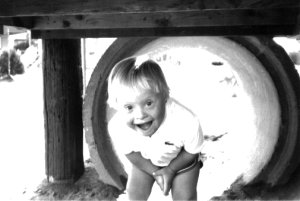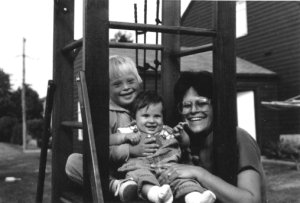The Exceptional Parent, Vol. 13, No. 6, December 1983, p. 49-52
Copyright ©1983 by Psy-Ed Corp. All Rights Reserved.
Subscriptions cost is $39.95 per year for 12 issues; Call (877) 372-7368. Offices at 555 Kinderkamack Road, Oradell, NJ 07649.
|
Jo Ann Simons Derr The Exceptional Parent, Vol. 13, No. 6, December 1983, p. 49-52 Copyright ©1983 by Psy-Ed Corp. All Rights Reserved. |
Reprinted with the expressed consent and approval of The Exceptional Parent, a monthly magazine for parents and families of children with disabilities and special health care needs. Subscriptions cost is $39.95 per year for 12 issues; Call (877) 372-7368. Offices at 555 Kinderkamack Road, Oradell, NJ 07649. |
Delayed speech development
 Jonathan, who turned four years old in May, has Down syndrome. During the first two years of his life, Jonathan was hospitalized a dozen times, twice for open heart surgery. Although Jonathan's heart condition is not related to Down syndrome, it is not uncommon for them to exist in the same child. Jonathan sat at 9 months, crawled at 14 months, and walked at 22 months. By the age of 15 months, he hadn't produced a single understandable word.
Jonathan, who turned four years old in May, has Down syndrome. During the first two years of his life, Jonathan was hospitalized a dozen times, twice for open heart surgery. Although Jonathan's heart condition is not related to Down syndrome, it is not uncommon for them to exist in the same child. Jonathan sat at 9 months, crawled at 14 months, and walked at 22 months. By the age of 15 months, he hadn't produced a single understandable word.
At 24 months, when most children are chattering away, Jonathan had a spoken vocabulary of only ten words. He used "git" (get) and "zat" (that) consistently and with meaning, but months would go by without a single new word. It was at this point in Jonathan's development that his primary-therapist at the Early Intervention Program suggested we begin teaching him simple signs for things like "food," "drink," and "more."
Early Intervention Programs are designed for children 0-3 years of age who have handicapping conditions or are at risk for developmental delays. The goal of early intervention (or infant stimulation, as it is called in some states) is to assist the child to function at his or her optimal developmental level and to support the family as it learns to accept the child and the disability. Services generally include speech, physical, and occupational therapy, social work, and educational and nursing services. The services can be provided at a specialized center, in the child's home, or in a day care setting.
At first, my husband and I were adamantly opposed to the suggestion that Jonathan be taught to use sign language. While sign language (manual symbols representing ideas and concepts) is used mainly by the deaf, it has begun to achieve limited use in the education of children like Jonathan who are language delayed but not hearing impaired.
But we wanted nothing to do with it. We wanted Jonathan to speak, and we feared that signing would discourage the development of spoken language. We also feared it would reinforce for him and other children the fact that he has a disability. Not only would he look different, we thought, but he'd also act differently.
I think one of the reasons we reacted so negatively to the idea of signing was that we had invested so much time and energy into teaching Jonathan how to function capably in his environment. He lived at home with two working parents. Much of his time was spent in a nearby day care center with non-disabled children. While we fully understood that someday he might need a more restricted educational setting, we wanted him to be as comfortable as he could in the able-bodied world. Somehow, the idea of teaching Jonathan to sign clashed with this philosophy. Eventually, his therapist withdrew the suggestion, and we continued to encourage oral speech.
Still no progress
Three months went by. Jonathan reached 27 months, and we weren't seeing any more progress in speech development. Although I was amazed at how well he understood what was said to him and how accurately he followed direction, I was also concerned with his frustration when he tried to make himself understood.
One day, just as an experiment, I showed Jonathan the sign for a new purchase-a child's toilet seat. I helped him make the sign (shaking fist with the thumb between the forefinger and middle finger) and he repeated it. The next day, when I asked him if he had to go to the toilet, he responded by signing "toilet." Surprised and joyful, I marched him down the hall. My surprise grew as he demonstrated again and again that he connected the sign with its meaning.
The reason I used the word "toilet" and not "potty" was that I felt mentally retarded children should be taught appropriate terminology. My husband and I have never spoken to Jonathan in baby talk because we wanted him to hear only those words which he would be expected to use. While a non-disabled child may make the transition easily from "potty" to "toilet" to express the need to use a bathroom, a mentally retarded child may continue to rely on the first words he or she was taught. I had seen too many mentally retarded adolescents asking "to go potty" for me to take the chance of exposing Jonathan to such expressions.
Speech therapy
When Jonathan readied 28 months, I arranged for him to have a speech evaluation so that the issue of signing could be resolved. His receptive language was determined to be at the 20-month level, and his expressive skills were scattered in the 16- to 20-month range. He had a spoken vocabulary of 10-15 words.
As a result of this testing, Jonathan began to receive speech therapy at his day care center twice a week. The Early Intervention Program, which no longer met all of Jonathan's needs, was traded for day care ten hours a day. This was supplemented by weekly physical and occupational therapy, in addition to the speech program. Oral speech was still emphasized, with only occasional work on signing.
However, the speech therapist soon became convinced through her work with Jonathan that more signing might be appropriate for him. Because he still wasn't demonstrating much motivation to speak, we finally capitulated.
The results were impressive. After only four months of intensive instruction in sign language, Jonathan had built a manual vocabulary of almost thirty words. This number soon increased to seventy words. At the same time, Jonathan began showing increased interest in oral speech. His speech therapist felt that signing should be continued, and I finally felt assured that the simultaneous use of sign language and oral speech was achieving the desired goal. Chet and I felt that someday we would be able to phase out signing as Jonathan gradually became more confident with the spoken language.
Minimizing differences
By three and a half years of age, Jonathan was using almost 200 signs and over 200 spoken words. He had learned his colors, was beginning to count, and had started to recognize some letters. He attended a summer day camp for non-disabled pre-schoolers, and, in the fall of 1982, he entered a language-based pre-school for disabled children, where signing is used to augment speech. After school, he continued to attend the day care center with the non-disabled friends he has known for years.
Has sign language reinforced Jonathan's differences as we originally feared? Not at all. The children's television program "Sesame Street" uses sign language almost daily and has made "talking with your hands" very popular with its viewers. Jonathan's day care friends have learned to "talk" to him and this shared "language" has minimized, rather than emphasized, the differences between them.
Now, at age four, Jonathan knows so many words and signs I am unable to keep track of them all. He speaks or signs in 3-5 word sentences and can initiate and carry on conversations with both children and adults. He uses his language to express feelings and to display his fairly sophisticated sense of humor. Jonathan's most important language achievement may be his interest in improving his articulation: he constantly attempts to correct himself to make it easier for his listeners to understand him.
The professional debate about signing with a child who is not deaf goes on. For families with a language delayed child, the debate is much more personal. We received much conflicting advice from friends and professionals, but, in the final analysis, we learned to take our cues from our child. Jonathan needed a way to communicate, to influence his environment, to ease his frustrations. Signing gave him that.
"I've been there"
 From my experience with Jonathan's speech, I have learned to make decisions concerning my son based on the information at hand and to stop worrying about "what if..." I have learned to balance my preferences with professional advice and to recognize when my wishes may not be in Jonathan's best interests.
From my experience with Jonathan's speech, I have learned to make decisions concerning my son based on the information at hand and to stop worrying about "what if..." I have learned to balance my preferences with professional advice and to recognize when my wishes may not be in Jonathan's best interests.
As director of advocacy for the North Shore (Massachusetts) Association for Retarded Citizens, Inc., I have the opportunity to work on local, state, and national issues which affect the lives of mentally retarded citizens and their families. A recent example is a telephone call I received from a woman who had found out just hours before that her newborn son had Down syndrome. She called me in fear after her pediatrician left her with little hope for her child's development. I was able to provide her with the hope and encouragement she needed to face an uncertain future.
I am proud of my agency's ability to say to the new, frightened parents of a disabled child, "We've been there. We can help." I know. I've been there myself.
Jo Ann Simons Derr has a master's degree in social work from the University of Connecticut. She is director of advocacy for the North Shore (Massachusetts) Association for Retarded Citizens Inc., and serves on the board of directors of the National Down Syndrome Congress. She and her husband Chet live with their son Jonathan and his new baby sister Emily in Swampscott, Massachusetts.